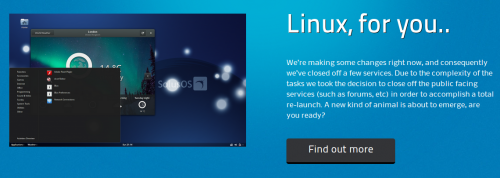
Debian begat Ubuntu who Begat Mint and Zorin who begat…
Sorry for going all biblical on you but you get the idea. At some point in the Linux world, most of us are beholden to code not written by us but still often changing it for the better.
But every now and then, you run into someone who is no longer happy with all the begitting, begotting and begatting.
He clearly sees how what he does can be improved, and he puts the wheels in motion to make it happen.
Meet Ikey Doherty, the creator of SolusOS.
Ikey came to make news with his SolusOS 1.X releases. Even as a young distro, SolusOS broke the 20th place at Distrowatch and ultimately climbed to the 14th position. Based on Debian, he wanted to change some things that were happening in other Debian-based distros. But even the most stable of foundations are made less stable by other things.
The complete blindside of the Gnome User community by Gnome 3 was a hell of a shock. In that SolusOS 1.X was built on Gnome 2.X, trying to keep up with the upstream changes began to take its toll. If it wasn’t Gnome breaking things, it was squabbles between warring camps not wanting to get along with each other. Meticulously tweaked themes would shatter with each new update and even the theme authors at Gnome-look.org got sick of having to keep up with it.
And we all witnessed the turmoil created by the Canonical group bringing forth Unity.
Don’t get me started.
So, taking a cue from the abandonment of Fuduntu, Ikey had a choice to make. As a coder and a distro developer, he did the only thing he could do.
He took a wrecking ball to the whole freakin’ thing, shoveled up the mess and started all over again. And for good reason.
The upstream folks had no intention of being careful not to break his things and they told him as much. Not to mention some of them were real jerks about it. Instead of joining the chorus of outrage, Ikey saw the futility in doing so and started from scratch.
 At first, even his loyal users were put off by the proposed changes. Ikey wasn’t going to base his package management on Debian or Red hat. He was going in a completely different direction.
At first, even his loyal users were put off by the proposed changes. Ikey wasn’t going to base his package management on Debian or Red hat. He was going in a completely different direction.
SolusOS 2.0 will be based on the PiSi package management system.
Pisi was first introduced to the world via Pardus Linux…an independent Linux distribution from Turkey. After a hiatus of two years, Pardus has returned to active development.
The Irony…?
New Pardus is now based on Debian-based package management.
Upon release, SolusOS 2.O will be the only actively-developed distro using the PiSi package management system. And that suits Ikey just fine.
Ikey isn’t just some hack that re-themed someone else’s work. Doherty is building SolusOS from the base up. He pays his bills by writing and/or debugging software for a major player in the IT industry, but his passion is SolusOS. The majority of his work as lead developer is package management. With PiSi, not only will his life be easier, PiSi is…well it’s easy PiSi. Even I can package stuff with PiSi…
And I don’t break things doing it. This comes from a man who is forbidden to touch a compiler in 17 states.
SolusOS will be based on Gnome 3.10. Ikey has temporarily shut down most of the SolusOS website as he works into the night and early morning getting SolusOS 2.0 ready. Ikey believes he can have a beta out for testing this month. Users have been alpha testing for two months. Ikey works a full-time job AND develops his distribution…he’s a busy guy.
And dedicated.
I should let it be known, I am a biased individual when it comes to SolusOS or Ikey Doherty. Ikey will be developing the official educational version of SolusOS for Reglue.
Oh, and just guess what I’ve named the custom SolusOS 2.0 educational version.
Yeah, I know, I know…it doesn’t make sense. It’s simply a play on words. But it’s easier to say or type than “The SolusOS Release of Reglue Educational distribution.”
So work continues on SolusOS 2.0. Ikey has every confidence he can return to the Distro Arena with a superior product. He’s aware that he will probably lose users but gain new ones quickly. People are nicely settled in with Debian packaging. Even at the command line. It’s hard to make changes in your life. I mean, it doesn’t get any easier than: Sudo apt-get -y install foo.
Remember the -y switch by the way…it saves you having to OK other packages that get pulled in.

Now it’s just a matter of waiting to see when the beta will be released. Doherty has promised a beautifully-improved Gnome 3.10. He will give us Gnome the way Gnome is supposed to work.
Knowing Ikey as I do…
I don’t for a minute doubt him.
Want to keep up with SolusOS? The best place to do so is from his Google Plus page.
That’s where all the cool kids hang out anyway.
All-Righty Then…

Ken Starks is the founder of the Helios Project and Reglue, which for 20 years provided refurbished older computers running Linux to disadvantaged school kids, as well as providing digital help for senior citizens, in the Austin, Texas area. He was a columnist for FOSS Force from 2013-2016, and remains part of our family. Follow him on Twitter: @Reglue








last I read SolusOS will ship with Xfce NOT Gnome
I mean Consort (not xfce)
but now it’s going to be Gnome according to the website… that fkn sucks man. Gnome 3xx is garbage
Actually he is not alone in using pisi. There’s also http://www.pisilinuxworld.org/blog, which is kind of a fork of Pardus.
Pardus was a great system and good international forum. I am curious how pisi is going in the future.
Looking forward to seeing the beta come out.
Am I correct in understanding that while using Debian/Gnome3.x as his base, he is NOT using deb/apt? Or is he building the whole thing from scratch and selected to use Pisi instead of any of the others?
Either way, I look forward to giving the beta a spin around the block – kick the tires and see how smooth it runs.
“The complete blindside of the Gnome User community by Gnome 3 was a hell of a shock.”
What? Whatever you think of GNOME 3, that’s just absurd. The GNOME 3 design was extensively discussed, argued over, previewed, blogged and social network-ed about before it showed up. GNOME Shell was available as a preview on multiple major distributions for months before GNOME 3.0 arrived. Whether you like it or not, it is implausible to claim to have been *surprised* by it.